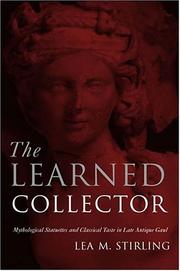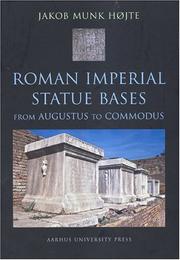| Listing 1 - 10 of 25 | << page >> |
Sort by
|
Book
Year: 2011 Publisher: [Place of publication not identified] : Perlego,
Abstract | Keywords | Export | Availability | Bookmark
 Loading...
Loading...Choose an application
- Reference Manager
- EndNote
- RefWorks (Direct export to RefWorks)
Book
ISBN: 8771841563 Year: 2019 Publisher: Aarhus, Denmark : Aarhus University Press,
Abstract | Keywords | Export | Availability | Bookmark
 Loading...
Loading...Choose an application
- Reference Manager
- EndNote
- RefWorks (Direct export to RefWorks)
"This book concerns the chronology of Roman mythological sarcophagi. The traditional chronology assumes a peak in production during the reign of Gallienus (AD 259-268) that fades away in the reign of Constantine. This chronology has some obvious flaws. The supposed peak under the reign of Gallienus, when the empire was falling apart, can only be described as a mirage. Some very fine sarcophagi were indeed produced in this period, but the number is very limited. With the reign of Constantine (AD 306-337) came wealth, and the so-called 'villa boom' that also revived sculpture in the round. At that time, it is believed that production of pagan sarcophagi had ceased to be replaced by Christian sarcophagi. This raises a very simple question, however: how were pagans buried? No doubt production of pagan sarcophagi continued beyond the turn of the century and Symmachus, who died in AD 402, was buried in such a sarcophagus."--Back cover
Book
ISBN: 9780300211818 0300211813 9780300214369 0300214367 Year: 2016 Publisher: New Haven (Conn.) : Yale university press,
Abstract | Keywords | Export | Availability | Bookmark
 Loading...
Loading...Choose an application
- Reference Manager
- EndNote
- RefWorks (Direct export to RefWorks)
"This groundbreaking study traces the development of Roman architecture and its sculpture from the earliest days to the middle of the 5th century BCE. Existing narratives cast the Greeks as the progenitors of classical art and architecture or rely on historical sources dating centuries after the fact to establish the Roman context. Author John North Hopkins, however, allows the material and visual record to play the primary role in telling the story of Rome's origins, synthesizing important new evidence from recent excavations. Hopkins's detailed account of urban growth and artistic, political, and social exchange establishes strong parallels with communities across the Mediterranean. From the late seventh century, Romans looked to increasingly distant lands for shifts in artistic production. By the end of the archaic period they were building temples that would outstrip the monumentality of even those on the Greek mainland. The book's extensive illustrations feature new reconstructions, allowing readers a rare visual exploration of this fragmentary evidence"--
Architecture, Roman. --- Sculpture, Roman. --- Architecture romaine --- Sculpture romaine --- Architecture, Roman --- Sculpture, Roman --- Roman sculpture --- Roman architecture
Book
Year: 2001 Publisher: Wien : Österreichisches Archäologisches Institut,
Abstract | Keywords | Export | Availability | Bookmark
 Loading...
Loading...Choose an application
- Reference Manager
- EndNote
- RefWorks (Direct export to RefWorks)
Die meisten der aus der Provinz Noricum stammenden römerzeitlichen Werkstücke aus Stein waren ursprünglich Teile von Grabbauten. Im vorliegenden Manuskript wird der Versuch unternommen, die architektonische Form dieser Grabbauten zu rekonstruieren, eine Typologie zu erarbeiten und daraus historische sowie kunsthistorische Schussfolgerungen zu ziehen. Aus der Form der Werkstücke, den technischen Bearbeitungsspuren sowie der Struktur und dem Inhalt der plastischen Darstellungen und Reliefs können Informationen für die Verwendung dieser Bauteile im architektonischen Zusammenhang gewonnen werden. Anhand eines Vergleichs mit den ganz erhaltenen norischen Grabbauten aus Sempeter deren Rekonstruktion einer ausführlichen kritischen Beurteilung unterzogen wird - und mit Grabbauten Italiens sowie anderer römischer Provinzen ist es in vielen Fallen möglich, einen Rekonstruktionsvorschlag zu erstellen. Zusätzliche Anhaltspunkte werden aus einer Zusammenstellung aller Grabungsbefunde gewonnen, bei denen bearbeitetes Steinmaterial vorkommt. Auf diesem Weg wird erstmalig ein Überblick über die in der Provinz Noricum vorhandenen Grabbautypen gewonnen. Die erstellte Typologie erlaubt auch eine Einordnung der meisten nicht rekonstruierbaren Einzelteile. Insgesamt werden 227 Werkstücke oder Werkstückgruppen im Katalogteil I den Grabbautypen 'Aedicula', 'Baldachin', 'Altar', Weiler', 'Gemauerter Grabbau', 'Tumulus' oder 'Umfassung' zugewiesen, teilweise rekonstruiert und Grossteils in zeichnerischen und fotografischen Abbildungen präsentiert. Die 414 Teile des Katalogteils II sind nicht eindeutig einem bestimmten Grabbautyp zuweisbar, doch kann in vielen Fallen ihre Position am Grabbau bestimmt werden. Katalogteil. III umfasst 44 Grabungsbefunde. Die Auswertung des im Katalogteil vorgelegten Materials geht auf die Einordnung der einzelnen Grabbautypen im architektur- und kunstgeschichtlichen Zusammenhang ein. Die chronologische Entwicklung und die spezifische norische Ausprägung der einzelnen Typen wird besprochen. Anhand der Inschriften und der Reliefdarstellungen wird der etwaige Zusammenhang von Grabbautypus und gesellschaftlicher Stellung der Grabinhaber untersucht. Mit Hilfe von Verbreitungskarten wird schliesslich die unterschiedliche Häufigkeit bestimmter Typen in den einzelnen Regionen der Provinz herausgearbeitet und hinterfragt. Im tabellarischen Anhang I sind aussagekräftige Masse und Proportionen bestimmter Architekturglieder aufgelistet. Anhang II fährt diejenigen Grabbauten oder Grabbauteile an, deren Typus bestimmt werden kann und deren Inhaber zumindest ansatzweise bekannt sind. Ein umfangreicher Abbildungsapparat verfolgt den Zweck, die vorgeschlagenen Rekonstruktionen und Einordnungen nachvollziehbar zu machen, indem auch die Stoss- und Ladeflächen samt ihrer technischen Details dokumentiert sind. Die rekonstruierten Grabbauten werden anschaulich dargestellt, jedoch ohne die Grenzen zwischen Originalbestand und Rekonstruktion zu verwischen.
Relief (Sculpture), Roman. --- Sepulchral monuments --- Themes, motives. --- Noricum --- History.
Book
ISBN: 9004384839 Year: 2019 Publisher: Leiden ; Boston : Brill,
Abstract | Keywords | Export | Availability | Bookmark
 Loading...
Loading...Choose an application
- Reference Manager
- EndNote
- RefWorks (Direct export to RefWorks)
Edited by G. Papantoniou, D. Michaelides and M. Dikomitou-Eliadou, Hellenistic and Roman Terracottas is a collection of 29 chapters with an introduction presenting diverse and innovative approaches (archaeological, stylistic, iconographic, functional, contextual, digital, and physicochemical) in the study of ancient terracottas across the Mediterranean and the Near East, from the Hellenistic period to Late Antiquity. The 34 authors advocate collectively the significance of a holistic approach to the study of coroplastic art, which considers terracottas not simply as works of art but, most importantly, as integral components of ancient material culture. The volume will prove to be an invaluable companion to all those interested in ancient terracottas and their associated iconography and technology, as well as in ancient artefacts and classical archaeology in general.
Book
ISBN: 1108304923 1108290035 1108307922 1108418430 9781108307925 9781108290036 9781108418430 9781108407106 1108407102 Year: 2018 Publisher: New York
Abstract | Keywords | Export | Availability | Bookmark
 Loading...
Loading...Choose an application
- Reference Manager
- EndNote
- RefWorks (Direct export to RefWorks)
Figural and non-figural supports are a ubiquitous feature of Roman marble sculpture; they appear in sculptures ranging in size from miniature to colossal and of all levels of quality. At odds with modern ideas about beauty, completeness, and visual congruence, these elements, especially non-figural struts, have been dismissed by scholars as mere safeguards for production and transport. However, close examination of these features reveals the tastes and expectations of those who commissioned, bought, and displayed marble sculptures throughout the Mediterranean in the Hellenistic and Roman periods. Drawing on a large body of examples, Greek and Latin literary sources, and modern theories of visual culture, this study constitutes the first comprehensive investigation of non-figural supports in Roman sculpture. The book overturns previous conceptions of Roman visual values and traditions and challenges our understanding of the Roman reception of Greek art.
Marble sculpture, Roman. --- Struts (Stone carving) --- Stone carving --- Roman marble sculpture

ISBN: 1282556002 9786612556005 0472025341 9780472025343 0472114336 6612556005 9781282556003 9780472114337 Year: 2005 Publisher: Ann Arbor
Abstract | Keywords | Export | Availability | Bookmark
 Loading...
Loading...Choose an application
- Reference Manager
- EndNote
- RefWorks (Direct export to RefWorks)
Mythology, Classical, in art. --- Marble sculpture, Roman --- Figurines --- Sculpture --- Collectors and collecting --- France, Southwest --- Antiquities, Roman.
Book
Year: 2015 Publisher: [Place of publication not identified] : Nomos Verlagsgesellschaft mbH & Co. KG,
Abstract | Keywords | Export | Availability | Bookmark
 Loading...
Loading...Choose an application
- Reference Manager
- EndNote
- RefWorks (Direct export to RefWorks)
Unter dem Begriff der imitatio heroica lassen sich Formen des Auftretens und der Darstellung historischer Personen zusammenfassen, die sich heroische Figuren zum Vorbild nehmen. Seit der Antike gehört dies zu den häufigsten Formen vor allem, aber nicht nur der Bildnisrepräsentation politisch oder kulturell bedeutender Personen. Der Sammelband Imitatio heroica, Heldenangleichung im Bildnis widmet sich erstmals epochen- und disziplinenübergreifend diesem Phänomen. Dabei wird ein Zeitraum von der Antike bis zum 18. Jahrhundert in den Blick genommen. Ein grundsätzlicher Phänomenaufriss und Fallstudien aus den Bild- und Literaturwissenschaften machen die formalen und semantischen Grundlagen, Bedeutungen und historischen Tiefendimensionen der imitatio heroica anschaulich. In Heldenangleichungen wird das Heroische in seinen je historisch, medial und sozial bedingten Formen erkennbar, vor allem aber im Hinblick auf seine sinnliche Erfahrbarkeit das spezifische Potenzial visueller und habitueller Ausdrucksformen.
Portrait sculpture, Roman. --- Heroes in art. --- Kings and rulers in art.

ISBN: 8779349064 9788779349063 9788779341463 8779341462 Year: 2005 Volume: 7 Publisher: Aarhus : Aarhus University Press,
Abstract | Keywords | Export | Availability | Bookmark
 Loading...
Loading...Choose an application
- Reference Manager
- EndNote
- RefWorks (Direct export to RefWorks)
This volume includes a catalogue of 2,300 known statue bases from nearly 800 sites throughout the Roman Empire. Moreover, since it covers a period of 250 years, it allows for the first time consistent geographic, chronological and commemorative patterns to emerge.
Bases (Architecture) --- Statues --- Sculpture, Roman. --- Roman sculpture --- Statuary --- Monuments --- Sculpture --- Architecture --- Columns --- Details --- Pedestals --- Sculpture, Roman --- Bases, Statue --- Pedestal stands --- Pedestal supports --- Statue bases --- Supports, Pedestal --- Stands (Furniture) --- Sculpture romaine
Book
ISBN: 9789088909542 9789088909559 9789088909566 9088909563 9088909547 9088909555 Year: 2021 Publisher: Leiden, Netherlands : Sidestone Press,
Abstract | Keywords | Export | Availability | Bookmark
 Loading...
Loading...Choose an application
- Reference Manager
- EndNote
- RefWorks (Direct export to RefWorks)
In life, the emperor Domitian (81-96 CE) marketed himself as a god; after his assassination he was condemned to be forgotten. Nonetheless he oversaw a literary, cultural, and monumental revival on a scale not witnessed since Rome's first emperor, Augustus. In tandem with an exhibition in the Rijksmuseum van Oudheden in Leiden and the Mercati Traianei in Rome, planned for 2021-2022, this volume offers a fresh perspective on Domitian and his reign. This collection of papers, produced by a group of international scholars, gives a wholistic and interdisciplinary approach to the emperor and his works that begins with an overview of Rome and its imperial system and ends with a reappraisal of Domitian and his legacy. The subject of memory sanctions after his death, Domitian's reputation has suffered as a result of the negative press he received both in antiquity and thereafter. Building upon recent scholarship that has sought to re-evaluate the last of the Flavian emperors, the papers in this volume present the latest research on Domitian's building programmes and military exploits as well as the literary sources produced during and after his reign, all of which paint a picture of an emperor who - despite being loathed by Rome's elite - did much to shape the landscape of Rome as we know it today.
E-books --- Emperors --- Emperors. --- Domitian, --- 81-96. --- Rome (Empire). --- Rome --- History --- Architecture, Roman --- Portrait sculpture, Roman --- Relief (Sculpture), Roman --- Rome--History--Domitian, 81-96. --- Emperors--Rome. --- Domitien, empereur romain, 0051-0096 --- Catalogues d'exposition
| Listing 1 - 10 of 25 | << page >> |
Sort by
|

 Search
Search Feedback
Feedback About UniCat
About UniCat  Help
Help News
News